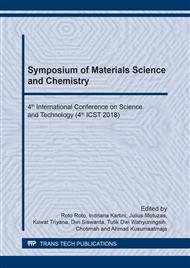[1]
K.S. Novoselov, A.K. Geim, S.V. Morozov, D. Jiang, Y. Zhang, S.V. Dubonos, I.V. Grigorieva, A. A. Firsov, Electric field effect in atomically thin carbon films, Science. 306.5696 (2004) 666-669.
DOI: 10.1126/science.1102896
Google Scholar
[2]
R. R. Nair, P. Blake, A.N. Grigorenko, K.S. Novoselov, T.J. Booth, T. Stauber, N.M.R. Peres, A.K. Geim, Universal dynamic conductivity and quantized visible opacity of suspended Graphene, arXiv. (2008) 0803.3718.
DOI: 10.1126/science.1156965
Google Scholar
[3]
P.R. Wallace, The band theory of graphite, Physical Review. 71.9 (1947) 622.
Google Scholar
[4]
A. D. Güçlü, P. Potasz, and P. Hawrylak, Excitonic absorption in gate-controlled graphene quantum dots, Physical Review B. 82.15 (2010) 155445.
DOI: 10.1103/physrevb.82.155445
Google Scholar
[5]
D. Pan, C. Xi, Z. Li, L. Wang, Z. Chen, B. Lu, M. Wu, Electrophoretic fabrication of highly robust, efficient, and benign heterojunction photoelectrocatalysts based on graphene-quantum-dot sensitized TiO 2 nanotube arrays, Journal of Materials Chemistry A. 1.11 (2013) 3551-3555.
DOI: 10.1039/c3ta00059a
Google Scholar
[6]
L. Tang, R. Ji, X. Cao, J. Lin, H. Jiang, X. Li, K.S. Teng, C.M. Luk, S. Zeng, J. Hao, S.P. Lau, Deep ultraviolet photoluminescence of water-soluble self-passivated graphene quantum dots, ACS nano. 6.6 (2012) 5102-5110.
DOI: 10.1021/nn300760g
Google Scholar
[7]
S. Zhu, J. Zhang, C. Qiao, S. Tang, Y. Li, W. Yuan, B. Li, L. Tian, F. Liu, R. Hu, H. Gao, H. Wei, H. Zhang, H. Sun, B. Yang, Strongly green-photoluminescent graphene quantum dots for bioimaging applications, Chemical communications. 47.24 (2011) 6858-6860.
DOI: 10.1039/c1cc11122a
Google Scholar
[8]
X. Chen, X. Zhou, T. Han, J. Wu, J. Zhang, S. Guo, Stabilization, and induction of oligonucleotide i-motif structure via graphene quantum dots, ACS nano. 7.1 (2012) 531-537.
DOI: 10.1021/nn304673a
Google Scholar
[9]
D. Pan, J. Zhang, Z. Li, M. Wu, Hydrothermal route for cutting graphene sheets into blue‐luminescent graphene quantum dots, Advanced materials. 22.6 (2010) 734-738.
DOI: 10.1002/adma.200902825
Google Scholar
[10]
S. Zhu, J. Zhang, X. Liu, B. Li, X. Wang, S. Tang, Q. Meng, Y. Li, C. Shi, R. Hu, B. Yang, Graphene quantum dots with controllable surface oxidation, tunable fluorescence and up-conversion emission, Rsc Advances. 2.7 (2012) 2717-2720.
DOI: 10.1039/c2ra20182h
Google Scholar
[11]
Y. Li, Y. Hu, Y. Zhao, G. Shi, L. Deng, Y. Hou, L. Qu, An electrochemical avenue to green‐luminescent graphene quantum dots as potential electron‐acceptors for photovoltaics, Advanced materials. 23.6 (2011) 776-780.
DOI: 10.1002/adma.201003819
Google Scholar
[12]
L. A. Ponomarenko, F. Schedin, M.I. Katsnelson, R. Yang, E.W. Hill, K.S. Novoselov, A.K. Geim, Chaotic Dirac billiard in graphene quantum dots, Science. 320.5874 (2008) 356-358.
DOI: 10.1126/science.1154663
Google Scholar
[13]
L. Tang, R. Ji, X. Cao, J. Lin, H. Jiang, X. Li, K.S. Teng, C.M. Luk, S. Zeng, J. Hao, S. P. Lau, Deep ultraviolet photoluminescence of water-soluble self-passivated graphene quantum dots, ACS nano. 6.6 (2012) 5102-5110.
DOI: 10.1021/nn300760g
Google Scholar
[14]
N. Mohanty, D. Moore, Z. Xu, T.S. Sreeprasad, A. Nagaraja, A.A. Rodriguez, V. Berry, Nanotomy-based production of transferable and dispersible graphene nanostructures of controlled shape and size, Nature communications. 3 (2012) 844.
DOI: 10.1038/ncomms1834
Google Scholar
[15]
S. Zhuo, S. Mingwang, and L. Shuit-Tong, Upconversion and downconversion fluorescent graphene quantum dots: ultrasonic preparation and photocatalysis, ACS nano. 6.2 (2012) 1059-1064.
DOI: 10.1021/nn2040395
Google Scholar
[16]
R.P. Choudhary, S. Shukla, K. Vaibhav, P.B. Pawar, S. Saxena, Optical properties of few layered graphene quantum dots, Materials Research Express. 2.9 (2015) 095024.
DOI: 10.1088/2053-1591/2/9/095024
Google Scholar
[17]
P. Russo, A. Hu, G. Compagnini, W.W. Duleyd, N.Y. Zhou, Femtosecond laser ablation of highly oriented pyrolytic graphite: a green route for large-scale production of porous graphene and graphene quantum dots, Nanoscale. 6.4 (2014) 2381-2389.
DOI: 10.1039/c3nr05572h
Google Scholar
[18]
X. Yan, C. Xiao, and L. Liang-shi, Synthesis of large, stable colloidal graphene quantum dots with tunable size, Journal of the American Chemical Society. 132.17 (2010) 5944-5945.
DOI: 10.1021/ja1009376
Google Scholar
[19]
J. Lu, P.S.E. Yeo, C.K. Gan, P. Wu, K.P. Loh, Transforming C 60 molecules into graphene quantum dots, Nature nanotechnology. 6.4 (2011) 247.
DOI: 10.1038/nnano.2011.30
Google Scholar
[20]
J.A. Johnson, C.J. Benmore, S. Stankovich, R.S. Ruoff, A neutron diffraction study of nano-crystalline graphite oxide, Carbon. 47.9 (2009) 2239-2243.
DOI: 10.1016/j.carbon.2009.04.016
Google Scholar
[21]
S. Stankovich, R.D. Piner, X. Chen, N. Wu, S.T. Nguyen, R.S. Ruoff, Stable aqueous dispersions of graphitic nanoplatelets via the reduction of exfoliated graphite oxide in the presence of poly (sodium 4-styrenesulfonate), Journal of Materials Chemistry. 16.2 (2006) 155-158.
DOI: 10.1039/b512799h
Google Scholar
[22]
H. Suhendar, A. Kusumaatmaja, K. Triyana, I. Santoso, Effect of Chemical Reduction Temperature on Optical Properties of Reduced Graphene Oxide (rGO) and its Potentials Supercapacitor Device, Material Science Forum, 901 (2017) 55-61.
DOI: 10.4028/www.scientific.net/msf.901.55
Google Scholar
[23]
S.L. Chin, and S. Lagacé, Generation of H2, O2, and H2O2 from water by the use of intense femtosecond laser pulses and the possibility of laser sterilization, Applied optics. 35.6 (1996) 907-911.
DOI: 10.1364/ao.35.000907
Google Scholar
[24]
M. Fox, Optical properties of solids, Vol. 3, Oxford university press, (2010).
Google Scholar


